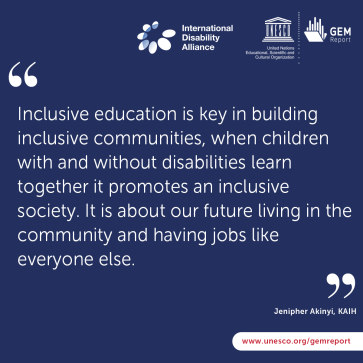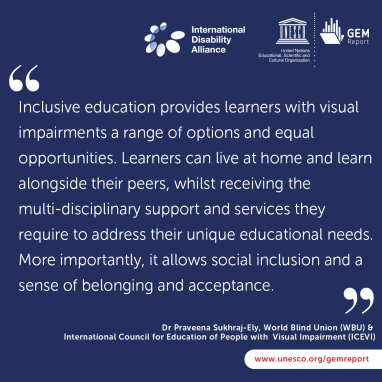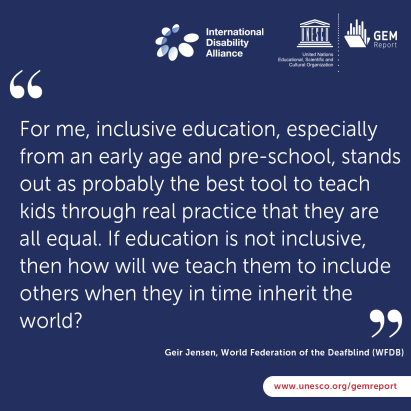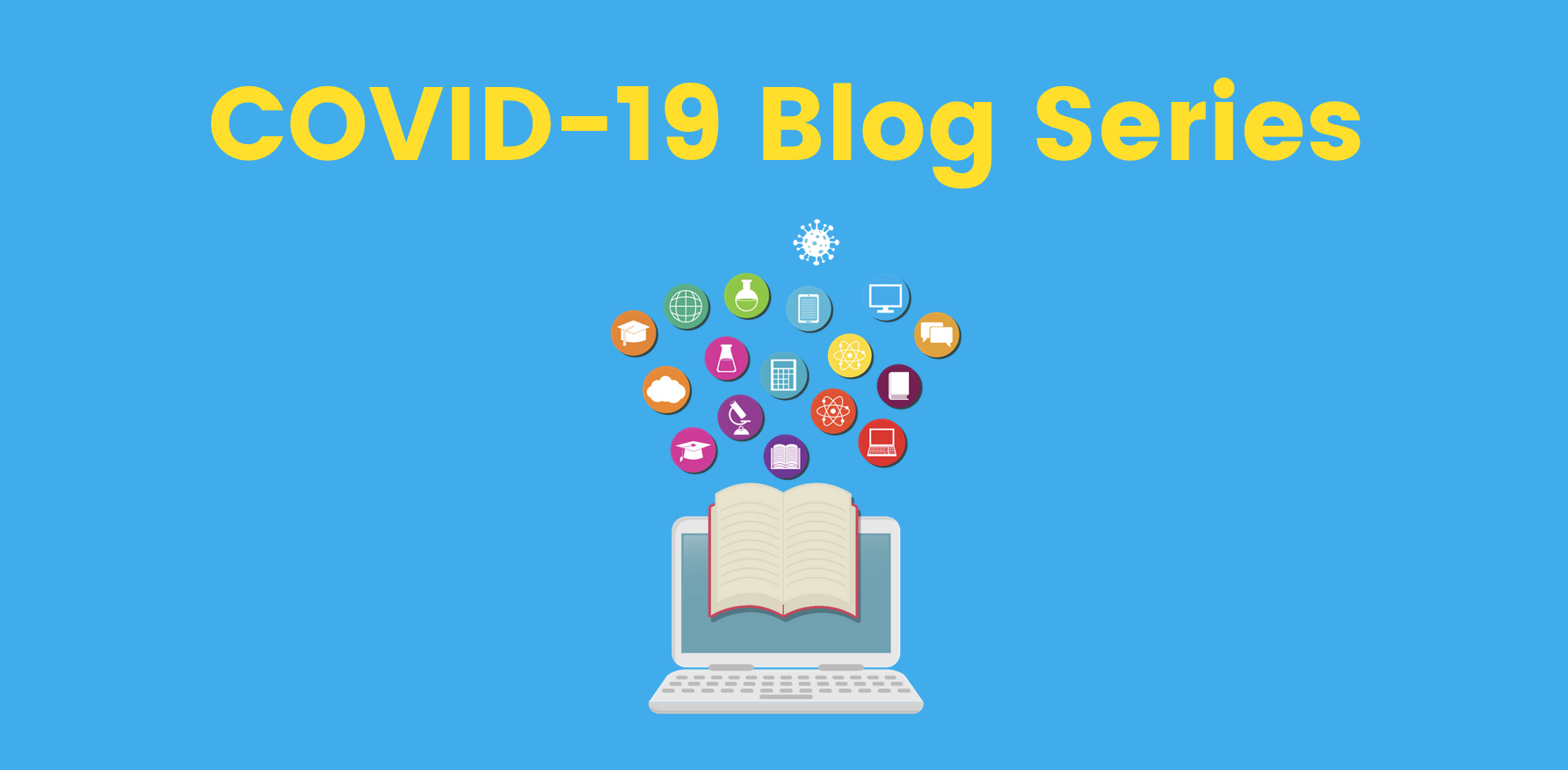By Ana Lucia Arellano, Chair, IDA and Manos Antoninis, Director, GEM Report
 Countries committed to achieve inclusive education by 2030 and yet almost a quarter of a billion are still out of school. Of these, children with disabilities are 2.5 times more likely to never go to school. Long before the outbreak of Covid-19, organizations working across the spectrum of education and inclusion have been calling for urgent action to address the education rights of students with disabilities.
Countries committed to achieve inclusive education by 2030 and yet almost a quarter of a billion are still out of school. Of these, children with disabilities are 2.5 times more likely to never go to school. Long before the outbreak of Covid-19, organizations working across the spectrum of education and inclusion have been calling for urgent action to address the education rights of students with disabilities.
Released shortly after the 2020 GEM Report on inclusion and education the International Disability Alliance (IDA) published its first global flagship report on education. The IDA Inclusive Education Report examines why children and youth with disabilities continue to be disproportionately excluded from education, and why those who do attend school usually receive a poorer quality education and fewer years of it. Both Reports call for an inclusive education system where all learners with and without disabilities learn together with their peers in schools and classes in their community schools, receiving the support they need in inclusive facilities.
The obvious commonalities between the 2020 GEM Report and the IDA Inclusive Education Report are far from coincidental. They signify growing momentum across the global disability movement to articulate a cross-disability consensus position on the implementation of SDG 4 in line with the UN Convention on the Rights of Persons with Disabilities (CRPD).
Stronger when together: Both reports provide governments and civil society with evidence-based recommendations to realise SDG 4 for all learners. Both call for investing in teacher training (including teacher diversity); collection of reliable data; application of universal design including in curricula; engaging with community, families and civil society; and targeted financing including for early intervention; among others.
 A co-hosted webinar by the GEM Report and IDA in late July, 2020, highlighted the significance of the cross-disability consensus position on moving away from special school models to truly inclusive schools. It raised awareness of the importance of a common positioning on the definition of inclusive education, which has polarised debates on disability and inclusion for many years. Selected quotes from some of the participants are included below.
A co-hosted webinar by the GEM Report and IDA in late July, 2020, highlighted the significance of the cross-disability consensus position on moving away from special school models to truly inclusive schools. It raised awareness of the importance of a common positioning on the definition of inclusive education, which has polarised debates on disability and inclusion for many years. Selected quotes from some of the participants are included below.
The importance of common definitions: The definition of inclusive education has evolved over time. Originally, the concept was understood as narrowly focusing on students with disabilities and was supported by a belief in expert knowledge, whereby specialists would teach students in separate classes. More recently, inclusive education has taken on a broader meaning, which is captured in both the 2020 GEM Report and the IDA Inclusive Education Report, and encompasses all learners no matter their identify, background or ability.
Addressing the inclusion of all marginalised learners, and not just one group, must be the core of education reform for inclusion. It is the only way to build quality, equitable, inclusive education systems for all learners. History has demonstrated that if education systems do not improve overall, they will not improve for children and youth with disabilities. Patchy efforts that focus on this or that group and attempts to overcome this or that obstacle have not been successful because the mechanisms of exclusion are similar for so many different groups. Calling for inclusion is not saying that individuals’ needs should be ignored, but the opposite. It is calling for all learners’ needs to be accommodated for in education systems, including those of students with disabilities.
The updated definition of inclusion seeks to reflect this evolution whilst also acknowledging the gains made by organizations of persons with disabilities (OPDs) over the past decades in strengthening access to education.
 A transformation of education as we know it. Inclusive education requires an educational transformation, which is unachievable if it is considered an add-on to, rather than the basis of, existing education systems . Inclusive education is to be considered the main pillar of quality inclusive employment.
A transformation of education as we know it. Inclusive education requires an educational transformation, which is unachievable if it is considered an add-on to, rather than the basis of, existing education systems . Inclusive education is to be considered the main pillar of quality inclusive employment.
We cannot deny that much needs to change for governments to meet the commitments of the UN CRPD and SDG 4. General Comment 4 to Article 24 of the UNCRPD was an important event, further clarifying not only that children with disabilities should not be discriminated against but also that they should be able to participate in the general education system. Despite these legal provisions we know that laws in a quarter of countries say that children with disabilities should be educated in separate settings, rising to 44% in countries in sub-Saharan Africa and over 50% in Asia.
The GEM Report set up an Advocacy Working Group on inclusion and education recognising that real progress will require joint and coordinated advocacy from OPD’s and education actors and new partnerships across sectors. IDA was represented on that group. Resulting reinforcing recommendations from both the IDA Inclusive Education Report and the 2020 GEM Report give a common message to policy makers of what priorities they need to put first. The IDA on-going Flagship group on Inclusive Education will develop further recommendations to ensure that the needs of learners with disabilities are addressed in the transformation to inclusive systems.





The objective focuses on quality, equitable, and inclusive education for all, which underscores SDG 4. This is because the importance and linkage of education to the development of any society cannot be over-emphasized. It argues that for a society to develop, education must be inclusive (including the physically challenged). It examines the prospect of inclusive education within the framework of the Sustainable Development Goals (SDGs) with particular reference to goal number four. It contextualizes this within the challenges facing the education system in Nigeria. The paper adopts a quantitative method of inquiry. A total of 200 copies of the questionnaire were distributed and 188 were retrieved and analyzed using the Statistical Package for Social Sciences (SPSS version 17.0) software. Preliminary findings suggest that the implementation of the Sustainable Development Goal (SDGs 4) in Nigeria’s education system towards the physically challenged is in serious jeopardy and requires immediate policy revalidation. The study concludes that for a meaningful development to be achieved by Nigeria, every citizen (physically challenged inclusive), must have access to knowledge, skills, and information.
LikeLike